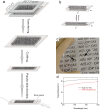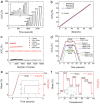Super-stretchable, transparent carbon nanotube-based capacitive strain sensors for human motion detection
- PMID: 24157842
- PMCID: PMC6505716
- DOI: 10.1038/srep03048
Super-stretchable, transparent carbon nanotube-based capacitive strain sensors for human motion detection
Erratum in
- Sci Rep. 2013;3:3402
Abstract
Realization of advanced bio-interactive electronic devices requires mechanically compliant sensors with the ability to detect extremely large strain. Here, we design a new multifunctional carbon nanotube (CNT) based capacitive strain sensors which can detect strains up to 300% with excellent durability even after thousands of cycles. The CNT-based strain gauge devices exhibit deterministic and linear capacitive response throughout the whole strain range with a gauge factor very close to the predicted value (strictly 1), representing the highest sensitivity value. The strain tests reveal the presented strain gauge with excellent dynamic sensing ability without overshoot or relaxation, and ultrafast response at sub-second scale. Coupling these superior sensing capabilities to the high transparency, physical robustness and flexibility, we believe the designed stretchable multifunctional CNT-based strain gauge may have various potential applications in human friendly and wearable smart electronics, subsequently demonstrated by our prototypical data glove and respiration monitor.
Conflict of interest statement
The authors declare no competing financial interests.
Figures




References
-
- Kim D.-H., Xiao J., Song J., Huang Y. & Rogers J. A. Stretchable, Curvilinear Electronics Based on Inorganic Materials. Adv. Mater. 22, 2108–2124 (2010). - PubMed
-
- Sekitani T. & Someya T. Stretchable, Large-area Organic Electronics. Adv. Mater. 22, 2228–2246 (2010). - PubMed
-
- Rogers J. A., Someya T. & Huang Y. Materials and Mechanics for Stretchable Electronics. Science 327, 1603–1607 (2010). - PubMed
-
- Sekitani T. et al. Stretchable active-matrix organic light-emitting diode display using printable elastic conductors. Nat. Mater. 8, 494–499 (2009). - PubMed
-
- Ko H. C. et al. A hemispherical electronic eye camera based on compressible silicon optoelectronics. Nature 454, 748–753 (2008). - PubMed
Publication types
MeSH terms
Substances
LinkOut - more resources
Full Text Sources
Other Literature Sources

